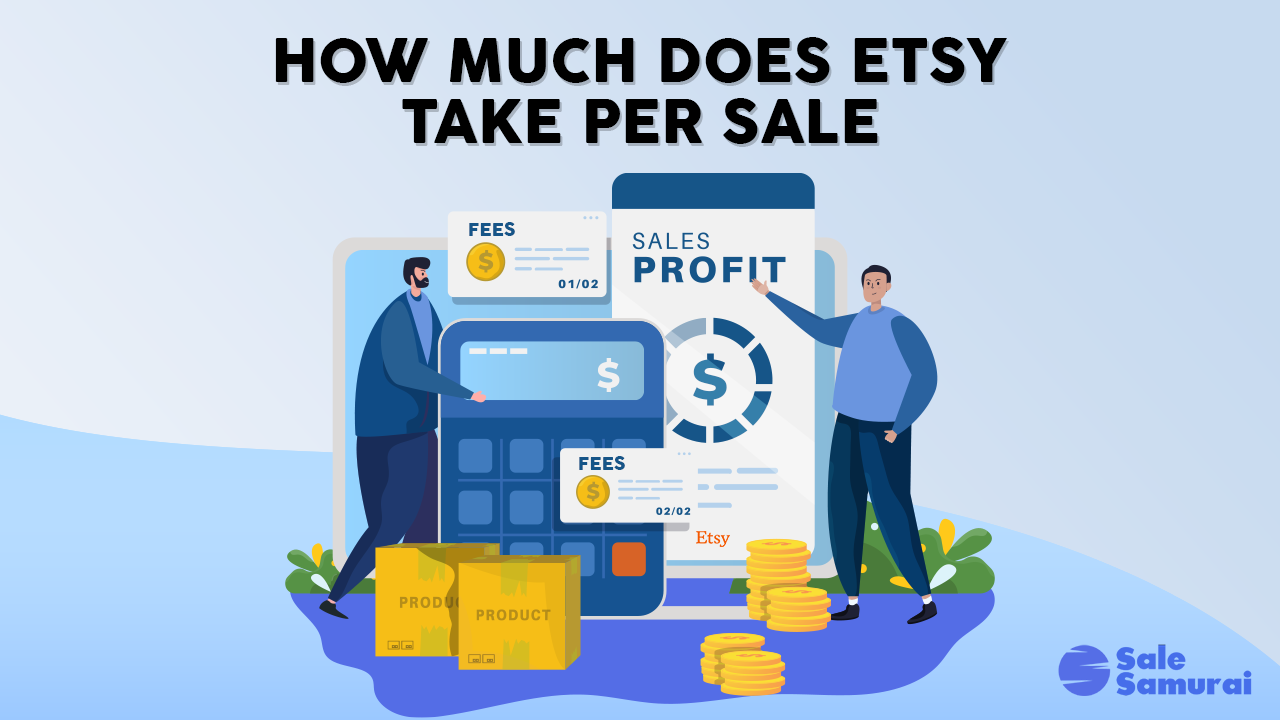
Etsy is an absolute game changer for crafters, makers, entrepreneurs, print on demand sellers, and more! This marketplace really caters to small businesses and artists and has opened up the doors to customers that were not reachable to many people in the past to turn hobbies or side gigs into full blown businesses.
Think about this for a minute.
In order to sell product, there are lot of pain points that might be holding you or HAVE held you back in the past. You would need to create a website, gain traffic to that website, calculate shipping, taxes and more. Gaining customer eyeballs can be the biggest issue for most sellers, and Etsy has streamlined the entire process. The buyers (customer eyeballs), ALREADY EXIST!
We know Etsy is great, but there is also the cost of doing business. When speaking to most sellers, we hear the Etsy fee structure come up time and time again because they vary so much, and can often be confusing. These fees may change, new ones may be added, but having a complete and full understanding of them is crucial to running a successful business.
In this article, we are going to go over Etsy’s pricing and the fees that they charge. We will go through some examples of products as if we were listing them on the Etsy marketplace and by the end, you will know exactly how to calculate the numbers you need!
Let’s get after it!
How Much Does Etsy Take? A Look At Etsy’s 2 Price Plans
There are two types of “subscription” options for sellers on Etsy. There is a free Standard plan (which we recommend that you start with if you are a brand new seller), and there is the Plus plan which is paid.
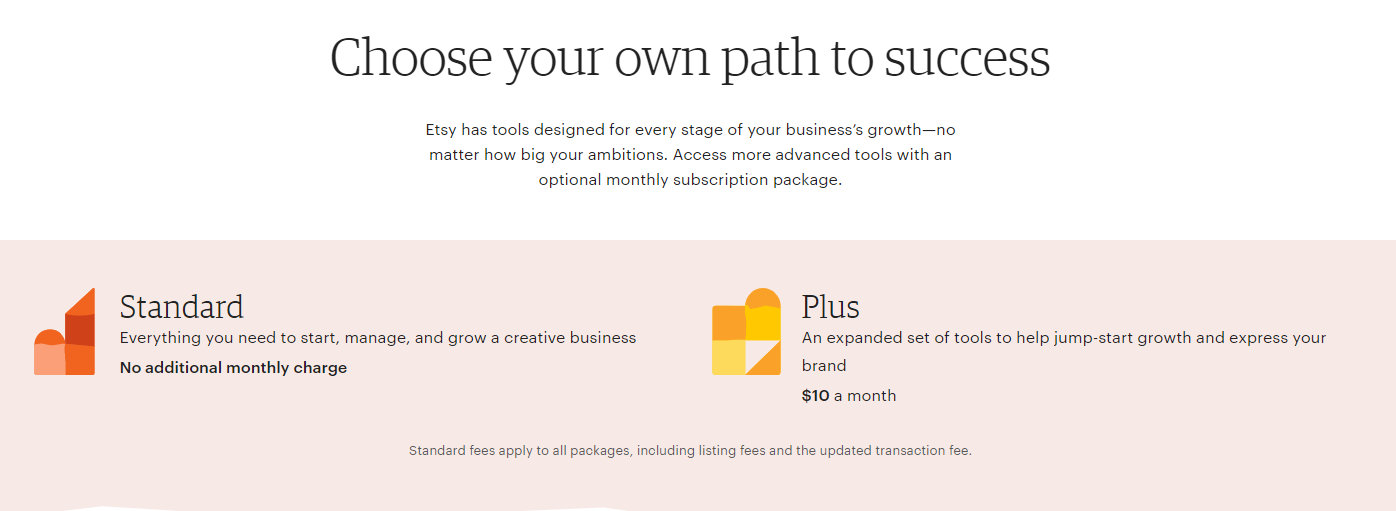
The Standard plan is Etsy’s free seller account. This gives you all of the basic tools that you need to get started and was at one point in time the only plan that Etsy offered. This will allow you as a seller to list products on Etsy, get discounts on postage, market your products and more. You will be able to access the Etsy app and you will NOT pay a monthly subscription fee.
The Plus plan is Etsy’s paid plan which is available at $10/month. This includes all of the features in the free plan with some additional features that could be useful depending where you are at in your Etsy journey. These are advanced shop customization options (layouts of featured listings, banner options, etc.), and restock requests for items that may be sold out.
You do end up getting some discounts or credits when using the Plus plan. These need to be used in the month period that you have a Plus account, and cannot be rolled over.
These include the following:
- 15 Listing credits (no more listing fees for these 15 items or renewals)
- $5 Etsy Ad Credit
- Advanced shop customization tools
- Back In stock notifications to potential customers
- 50% off custom .com/.store web addresses
We recommend that you start off with the free plan, but if you are already an Etsy seller, let’s discuss all of the fees that you will need to take into account to make sure you are running a tight ship!
Etsy Fees To Be Aware Of
Let’s go through the different type of fees that you are going to see as an Etsy seller no matter what kind of product you are selling, and then to really illustrate how this works, we will go through an example as if we were selling a mock product.
Here are some of the expenses that you need to know about when selling your items on Etsy. Understanding these charges and fees from the marketplace is crucial to making sure you are pricing your products correctly and making good business decisions.
1: Listing Fees
Each and every time you publish a listing on Etsy, you are going to be subject to a listing fee. This will occur for each product you list, no matter if it is a physical or a digital good.
The listing fee for publishing on Etsy will cost you $0.20 which will ensure an active listing for four months. After this four month listing period, your listing will “expire” and will need to be put back up. You can set your product to either auto-renew, or renew it manually.
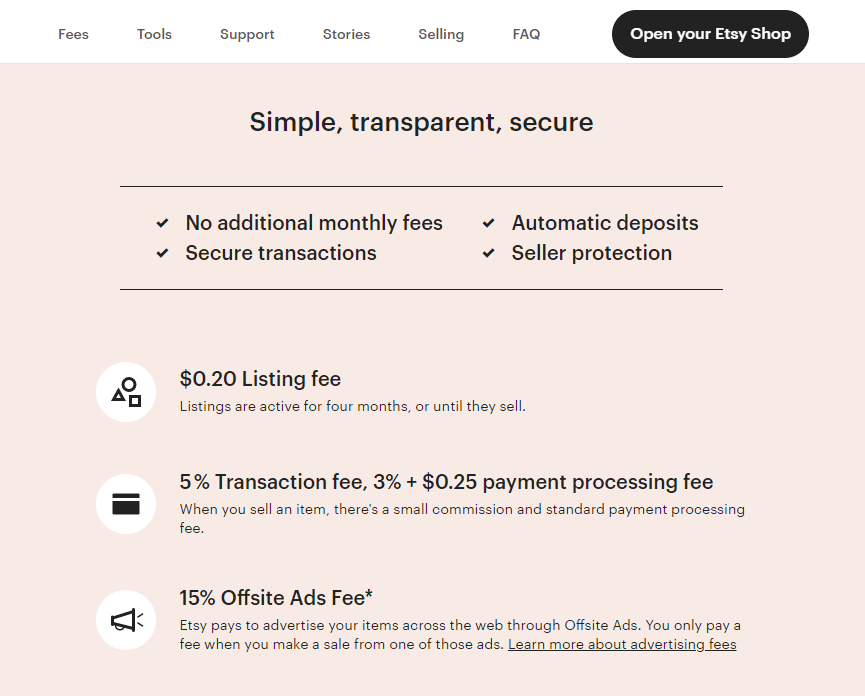
The way Etsy incorporates these charges is that it essentially forces you to renew your listings every QUARTER. If you have 1 product, and want it to be available for an entire year, you would be paying $0.20 X 4, or $0.80. This is not paid up front, but once per quarter (per listing).
You will need to pay a $0.20 listing fee on Etsy regardless of your product selling or not.
2: Auto-Renewal Fees
This will only come into play if you have set your listings to automatically renew every quarter. If you have this option turned on in each product that you list, Etsy will renew your listing at the end of the four-month listing period and you will be charged the $0.20 listing fee.
This will continue happening until you turn off automatic renewals, so if you are testing out new products and are not sure if they are going to sell, you may want to set your product to manual renewal.

Looking at the screenshot above, you will see the different options when listing your products. If you do decide to go for a manual renewal, at the end of the 4 month period, your listing will then expire, and it will no longer be offered for sale unless you log in and renew it.
Note: If you are not a USA seller, or your bank is not in USD, the amount you are charged per listing may vary a bit based on the exchange rates.
3: Transaction Fees
If you have been listing on Etsy, putting forth the practices we laid out for proper Etsy SEO, and even using the Sale Samurai software, chances are that you are making sales.
Great work!
…but now you have another fee to worry about. This is something that is unavoidable when selling on Etsy, the transaction fee.
When you make a sale from your Etsy store, you will be charged a 5% transaction fee on the price of your listing, plus an additional 5% shipping transaction fee (which applies to the shipping rate that is collected).
Let’s go over an example.
Example:
You are selling an item for $19.99 and are charging a $5.99 for shipping that you are collecting from the customer (this is if you are NOT offering free shipping). You will be charged a transaction fee of 5% on $25.98. Why $25.98? Because this is the cost of the product, plus the shipping. This will be equal to $1.299 or $1.3 as a transaction fee. This would be the exact same if you were offering a $25.98 product with zero shipping included.
Note: If you are offering a good for sale that includes a personalization and are charging for that, the amount charged will be added to the product costs, and 5% will be the transaction fee for the entire sale.
4.Multiple Product Sale Fees
So far, this is all pretty straight forward. But what happens if you list a product for sale and have a quantity of 10 available?
Well, you only pay the initial $0.20 listing fee, and would pay the transaction fee when something sells.
However, many Etsy sellers forget about the Multiple Product Sale.
If you sell more than 1 item in a single Etsy order (transaction), you have already been charged for listing that first item.
Etsy will charge you $0.20 each for the extra quantity that you sell.
Example:
You added a mug to your store and have 15 of them for sale. If a customer buys 2 mugs from you, you will be charged $0.20 as a multiple product sale (because that is 1 extra than the single listing you have already paid for). If the customer orders 4 of the same mug, you would pay an extra $0.60 (4 products X $0.20 since the first product listing has already been paid).
You are ONLY charged this extra fee when you actually SELL a multiple of a single product. If you do not, or you wish to renew your listing, you will be charged the flat $0.20.
5: Payment Processing Fees
Yes, there are fees to actually process the payment of your customers on Etsy! This is on top of the transaction fee.
Think of the transaction fee as the fee to actually have your products be seen and purchased on the Etsy marketplace, whereas the payment processing fee, is simply the fee for covering the credit card purchase.
Each time you swipe your card at the grocery store, the card issuer (Visa, MasterCard, etc.), actually charges the grocery store a small fee. What Etsy does, is pass this back to you since we are not accepting cash here.
There are two types of payments you can set up on Etsy. One is something we all know, PayPal, while the other is more streamlined and is called Etsy Payments.
5.1 Etsy Payments

To use Etsy payments for your processing needs, you are going to run into about a 3% processing fee + $0.25. This will then allow you to accept payment from your buyers of your products from lots of different payment options:
- Major Credit Cards
- PayPal
- Apple Pay
- Google Pay
- Etsy Gift Cards
- Debit/Bank Cards
- Klarna
- Sofort
- iDEAL
What this essentially does is take away the barrier of someone paying for your product, and you can then get paid with any of those services without setting them up yourself.

This will be the main way that you will use to accept payments from buyers on Etsy.
That being said, you need to make sure that you take a look at the countries that are eligible for Etsy payments (this is going to be a LOT of them).
If your country is not in the list of Etsy payments, then you may want to look into accepting PayPal directly.
5.2 PayPal
If you are not in the list of countries where you are eligible to use Etsy payments, then you will need to use PayPal to accept payments from your customers. If you have to go this way, PayPal will charge a 2.9% fee + $0.30 per transaction.
To set up PayPal, you will want to make sure to follow these instructions directly from Etsy.
Example:
If you are using Etsy Payments, your processing fee is 3% of the total transaction amount + $0.25.
If you are using PayPal, your processing fee is 2.9% of the total transaction amount + $0.30.
That means, if you are selling an item for $19.99, then 3% of that is $ $0.6 + $0.25 so your payment processing fee would be $0.85.
6. Currency Conversion Fee
If you are not a United States seller and you are selling in a currency that is not the same as your bank account that you have on file, then there is going to be an extra fee associated with the currency conversion when you get a deposit.
This currency conversion fee will be 2.5%.
7: Offsite Ad Fees
Etsy has a really great program to advertise your products directly ON the Etsy platform. You can choose to turn these on or not (we recommend that once you pass the selling learning curve, to really take a look at these).
However, Etsy also purchases offsite advertising from a network of partners, social networks, and search engines.
If you made under $10,000 in the past year, you are able to opt out of using offsite ads. Remember, fees come into play only when you make a sale that is linked to one of these ads.
IF you made under $10,000 in the last year (trailing 365 days), then you will be subject to a 15% fee if a sale was attributed to Offsite ads. Remember, you do not need to run these ads, and you can opt out.
IF you made OVER $10,000 in the last year (trailing 365 days), then you will be subject to a 12% fee if a sale was attributed to Offsite ads.
Now, here is where it gets confusing.
Etsy recently made a switch to their ad policy.
Before, you could opt IN or OUT of ads, no matter what. All you would have to do is pay either a 15% or a 12% fee (depending on the volume of your shop in the last year) for any orders attributed to these offsite ads.
The new policy, however, is much different.
If your shop has made sales of $10,000 USD in the prior 365 days, you may NOT opt out of offsite ads, and are subject to a 12% fee for any item that sells in your shop attributed to an offsite ad that Etsy is running.
Keep this in mind when pricing your product if you are a higher volume seller. Forgetting this simple change can easily put your product into the RED for something you may not have even asked for!
8: In-Person Selling Fees
This may not apply to everyone reading this, but Etsy also offers the ability to sell in person through their platform. Etsy partnered with Square to offer their marketplace sellers to do exactly this: sell in person! You will need a card reader from Square, and you will pay the usual fees, but you will also have a 2.5% + $0.10 fee for processing through Square. This will mean you do not pay the 5% Etsy transaction fee, but this one instead.
Is Etsy Worth It For The Amount They Take Per Sale?
If you have made it this far, you probably are thinking to yourself that that is a LOT of fees. Is it even worth it?
That is going to depend on factors that only you can answer for your own business. How are your profit margins? Can you sell the product at a good price? Is a built-in customer system and easy operating environment worth it?
If you really want to make Etsy work well for your business, you NEED to know your numbers and keep track of them. If you are not paying attention, months can go by without realizing that you are losing money on each sale!
Just so you can see at a glance what Etsy is taking, here it is broken down:
- 5% of the product price as a transaction fee
- 5% of the shipping costs (if there are any) as a shipping transaction fee
- 3% + $0.25 as a payment processing fee
- $0.20 as a listing fee that expires every quarter (four months)
- Total Fees: (5% (of total transaction price)) + (3% + $0.25) + $0.20 (listing fee) = 8% of the total cost of product/shipping + $0.45
Example:
Say you are selling a product that costs you $10 to make and you are going to sell it for $20 on Etsy and charge $5 for shipping. Here is what the fees would look like:
- Shipping Costs = $5.00
- 5% transaction fee = $1.00
- 5% shipping transaction fee = $0.25
- 3% + $0.25 payment processing fee: $1.00
- $0.20 listing fee = $0.20
- Total Expenses (With shipping) = $7.45
Now keep in mind, in this example, we are also charging the customer for shipping, so this is mostly a wash. You have to pay to ship the product, but they will pay you for that shipping. You DO get hit with a transaction fee on that shipping, but you can use this calculation to see how much profit you would be making.
The shipping is a wash, they pay $5, your shipping cost is $5. So you are selling a $20 product.
It costs you $10 to make.
You then subtract the rest of the fees and are left with your profit! In this example, you may want to increase the cost of your product as the profit margin is very low.
These fees may seem like a lot, but remember that the audience is built in, and there is no need to maintain an external website. For the fees that Etsy does take, they do offer a great outlet and service to make money.
Did you know the average Sale Samurai user has increased their listing visibility by 180%?
Sale Samurai Team
Sale Samurai is your all-in-one tool for massive Etsy growth. With thousands of users and years of e-commerce experience, Sale Samurai is built by sellers with the data and analytics in mind that you need for a successful Etsy shop. Start with a free account to explore how Sale Samurai can help expand your business today.
Leave a Comment Cancel reply
- Instagram vs. TikTok vs. YouTube: Which Platform Is Best for Promoting Your Etsy Shop?
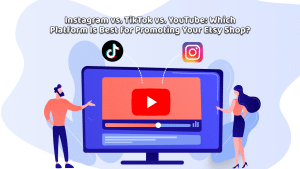
- How to Use Instagram Influencers to Promote Your Etsy Shop with Sale Samurai
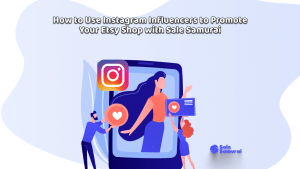
- How to Use TikTok to Market Your Etsy Shop and Increase Sales
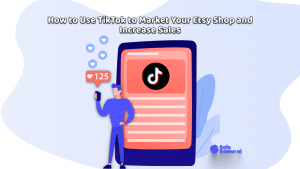
- How to Use YouTube Influencers to Promote Your Etsy Shop with Sale Samurai
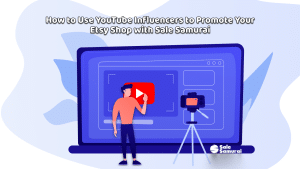
- Spring into Sales: Seasonal Trends to Watch for in 2025

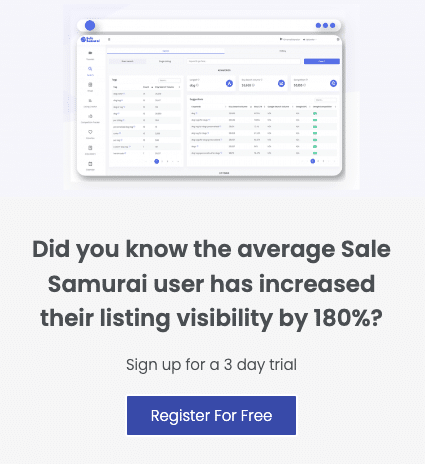
2 Comments
Steve Reed
In my spread sheet Etsy ACTUALLY Took:
Jan 22 – 11.2%
Feb 22 – 11.6%
Mar 22 – 11.3%
Apr 22 – 12.40%
May 22 – 12.90%
Their advertised 6.5% is stuck a lie/marketing scam – BUT Ebay took as high at 20.10% of my May 22 sales. When you put it all in spread sheets you might be amazed. BUT for the traffic and sales, it’s still worth it to me.
Steve Reed
Wait WHERE did my last comment go – why would you delete it?
My actual and true Etsy fees are: 11 – 12%, far from Etsy advertised percent.
I have real world data and would like to hear what other REAL sellers fees actually are.
Even at 12%, I can live with that – still better than Ebay’s 15% – 20% fee .
Please EMAIL me WHY you deleted my last comment.
So I don’t lost faith in Sale Samurai. Thank you